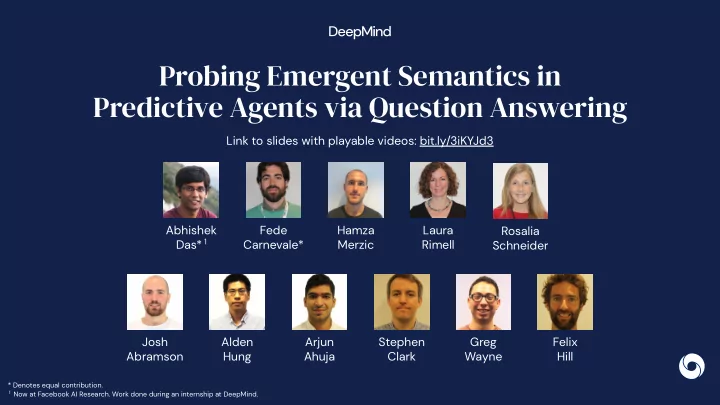

Probing Emergent Semantics in Predictive Agents via Question Answering Link to slides with playable videos: bit.ly/3iKYJd3 Abhishek Fede Hamza Laura Rosalia Das* 1 Carnevale* Merzic Rimell Schneider Josh Alden Arjun Stephen Greg Felix Abramson Hung Ahuja Clark Wayne Hill * Denotes equal contribution. 1 Now at Facebook AI Research. Work done during an internship at DeepMind.
Self-supervised representation learning Reinforcement Language Vision Learning http://jalammar.github.io/illustrated-bert Devlin, Jacob, et al. "Bert: Pre-training of deep bidirectional transformers for language understanding." arXiv:1810.04805 (2018). Pathak, Deepak, et al. "Context encoders: Feature learning by inpainting." CVPR 2016. Pathak, Deepak, et al. "Learning features by watching objects move." CVPR 2017. Wayne, Greg, et al. "Unsupervised predictive memory in a goal-directed agent." arXiv:1803.10760 (2018). Ha, David, and Jürgen Schmidhuber. "World models." arXiv:1803.10122 (2018).
How much objective knowledge about the external world can be learned through egocentric prediction?
Question-answering (in English) as an evaluation tool for investigating how much environment knowledge is encoded in an agent’s internal representation Intuitive: simply ask an agent what it knows about its world ● and get an answer back Open-ended: pose arbitrarily complex questions to an agent ●
Environment 5
Environment Environment Unity-based; runs at 30 fps ● 96 x 72 RGB first-person view ● 50 objects types ● 10 colors 3 sizes Agent First person view ● 8-D action space: ● Move-{forward, backward, left, right} Look-{up, down, left, right} 6
Training task: Exploration +1 reward for unvisited object 0 reward for visited object rewards refresh once all visited 7 Top-down view shown for illustration purposes. The agent only has access to first-person observations.
Training task: Exploration +1 reward for unvisited object 0 reward for visited object rewards refresh once all visited 8 Top-down view shown for illustration purposes. The agent only has access to first-person observations.
Evaluation probe: Question-answering What is the color of the bed? How many wardrobes are there? What is the object near the bed? Is there a basketball in the room? ... 9 Top-down view shown for illustration purposes. The agent only has access to first-person observations.
Evaluation probe: Question-answering Questions are programmatically generated in a manner similar to CLEVR (Johnson et al., 2017) 10
Evaluation probe: Question-answering Gradients from question-answering are not backpropagated into the agent. 11 Top-down view shown for illustration purposes. The agent only has access to first-person observations.
Setup How many wardrobes are there? What is the color of the bed? What is the object near the bed? Is there a basketball in the room? ... (i) (ii) During training, the agent explores During evaluation, we probe the agent’s and learns to build representations internal representations on a from egocentric observations question-answering task 12 Top-down view shown for illustration purposes. The agent only has access to first-person observations.
Agent architecture 13
Agent architecture 14
Agent architecture 15
Agent architecture 16
Agent architecture 17
Agent architecture 18
Agent architecture 19
Agent architecture 20
Agent architecture Action-conditioned forward prediction ● Multiple steps into the future ● Self-supervised ● 21
Agent architecture 22
Agent architecture Gradients from the question-answering decoder not backpropagated into the agent 23
Agent architecture 24
Baselines and Oracle Baselines 25
Baselines and Oracle Baselines Question-only: no vision ● 26
Baselines and Oracle Baselines X Question-only: no vision ● LSTM: no auxiliary predictive loss ● 27
Baselines and Oracle Baselines Question-only: no vision ● LSTM: no auxiliary predictive loss ● Predictive losses CPC|A (Guo et al., 2018) ● SimCore (Gregor et al., 2019) ● 28
Baselines and Oracle Baselines Question-only: no vision ● LSTM: no auxiliary predictive loss ● X Predictive losses CPC|A (Guo et al., 2018) ● SimCore (Gregor et al., 2019) ● Oracle No SG: QA decoder without stop gradient ● similar to Embodied / Interactive Question Answering (Das et al., 2018, Gordon et al., 2018) 29
Results: shape questions Oracle SimCore CPC|A LSTM Question-only Training steps 30
Results: overall 63% 60% Top-1 QA Accuracy 32% 31% 29% 31
Results 32
Q: What is the aquamarine object? A: Grinder Top-3 answer Answer predictions probabilities P(“Grinder”) 33
Q: How many blue objects are there? A: One Top-3 answer predictions P(“One”) P(“Three”)
Q: How many yellow objects are there? A: Four Top-3 answer predictions P(“two”) P(“four”) P(“Three”)
Compositional generalization Train-Test split Question e n l p e e d r SimCore e u u r e l b p g r . . . ball grinder Answer chair … bed Seen: What shape is the blue object? Bed Seen: What shape is the green object? Ball Unseen: What shape is the green object? Bed 36
Top-down map prediction 37
Top-down map prediction Top-down Map 38
Top-down map prediction 39
Conclusions Question-answering to probe ● internal representations, enabling evaluation of agents using natural linguistic interactions. Self-supervised predictive agents, ● such as SimCore, capture decodable knowledge about the environment, while non-predictive agents and CPC|A don’t. Generalization of the decoder ● suggests some degree of compositionality in internal representations. arxiv.org/abs/2006.01016 ●
Recommend
More recommend